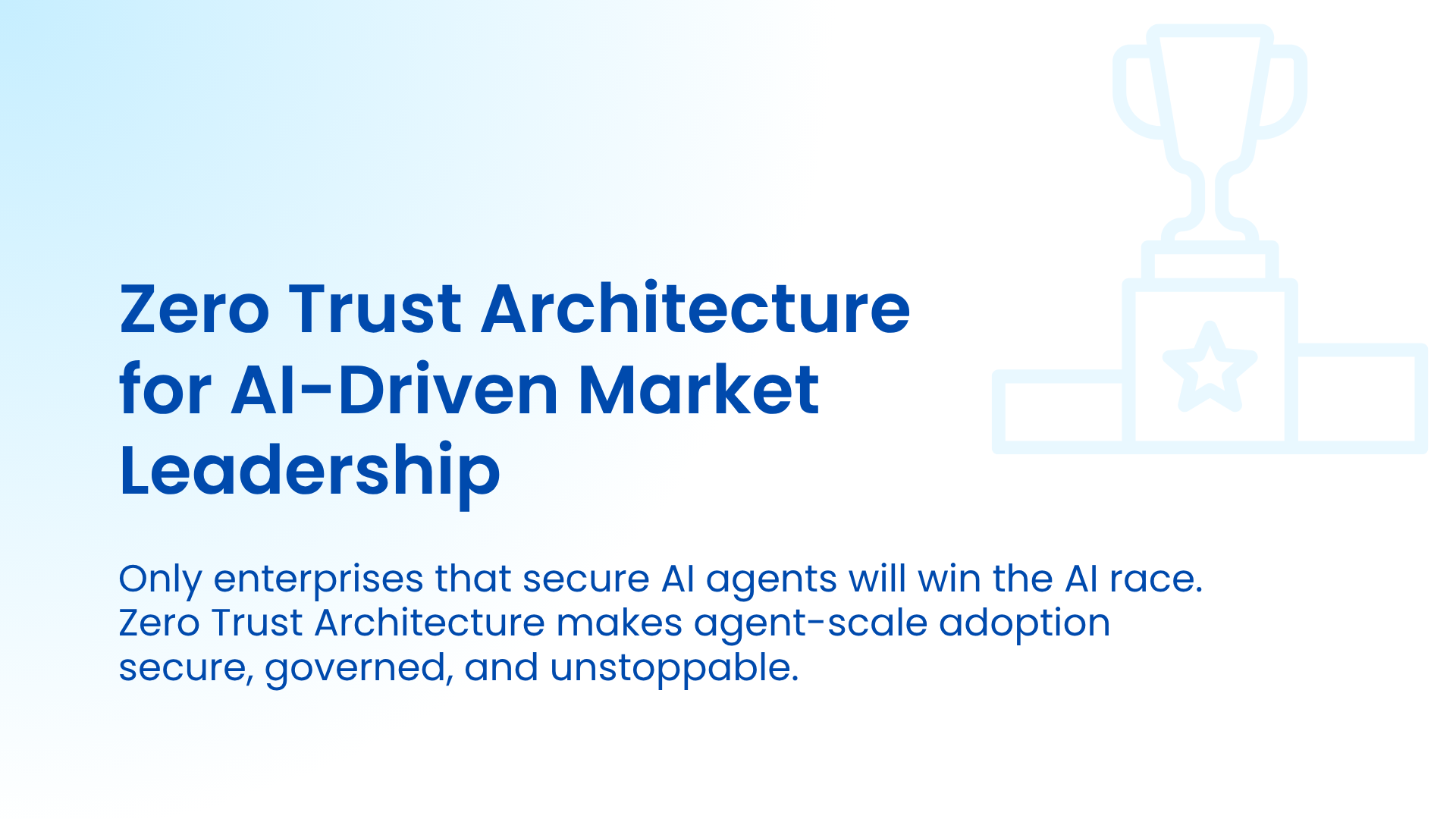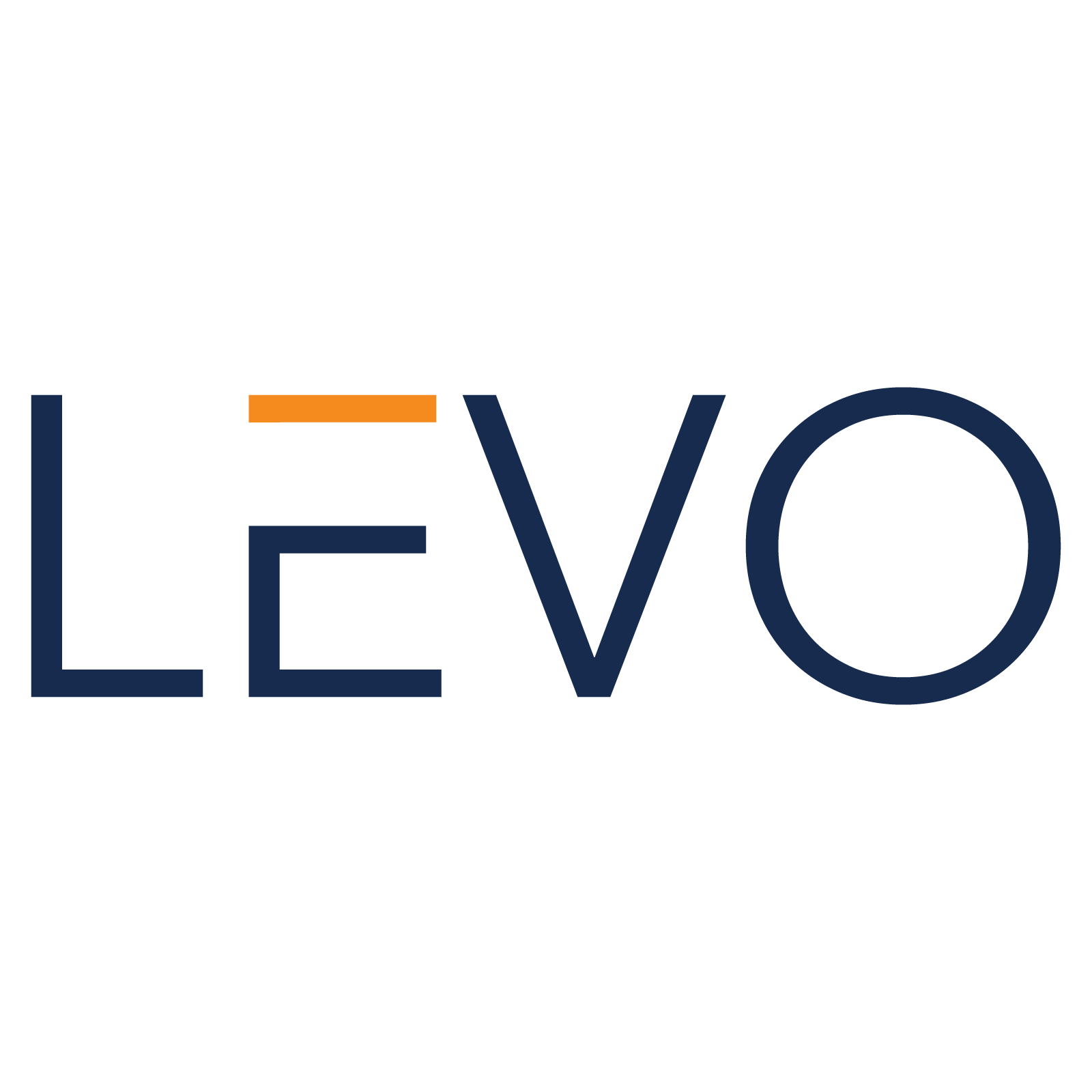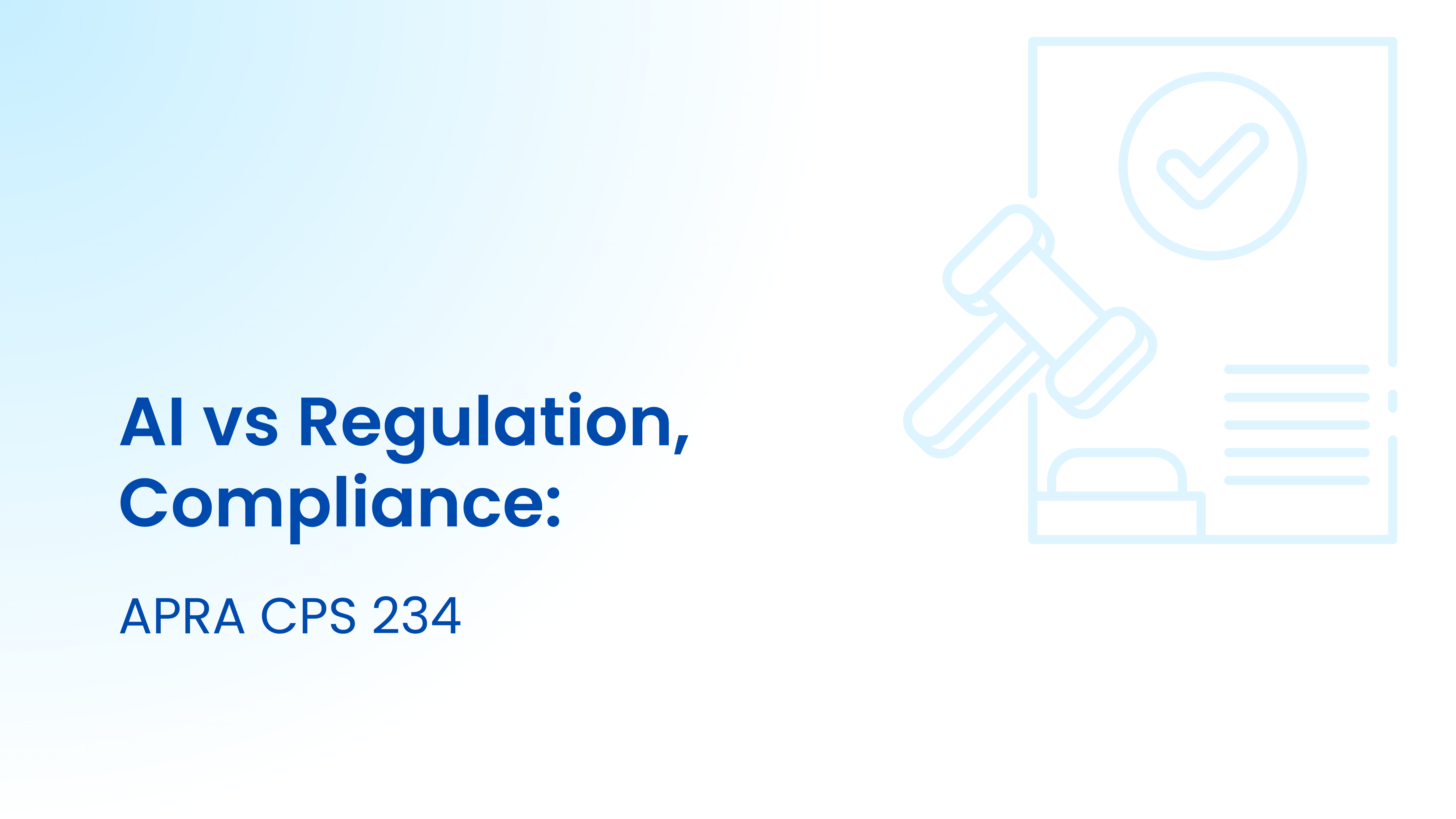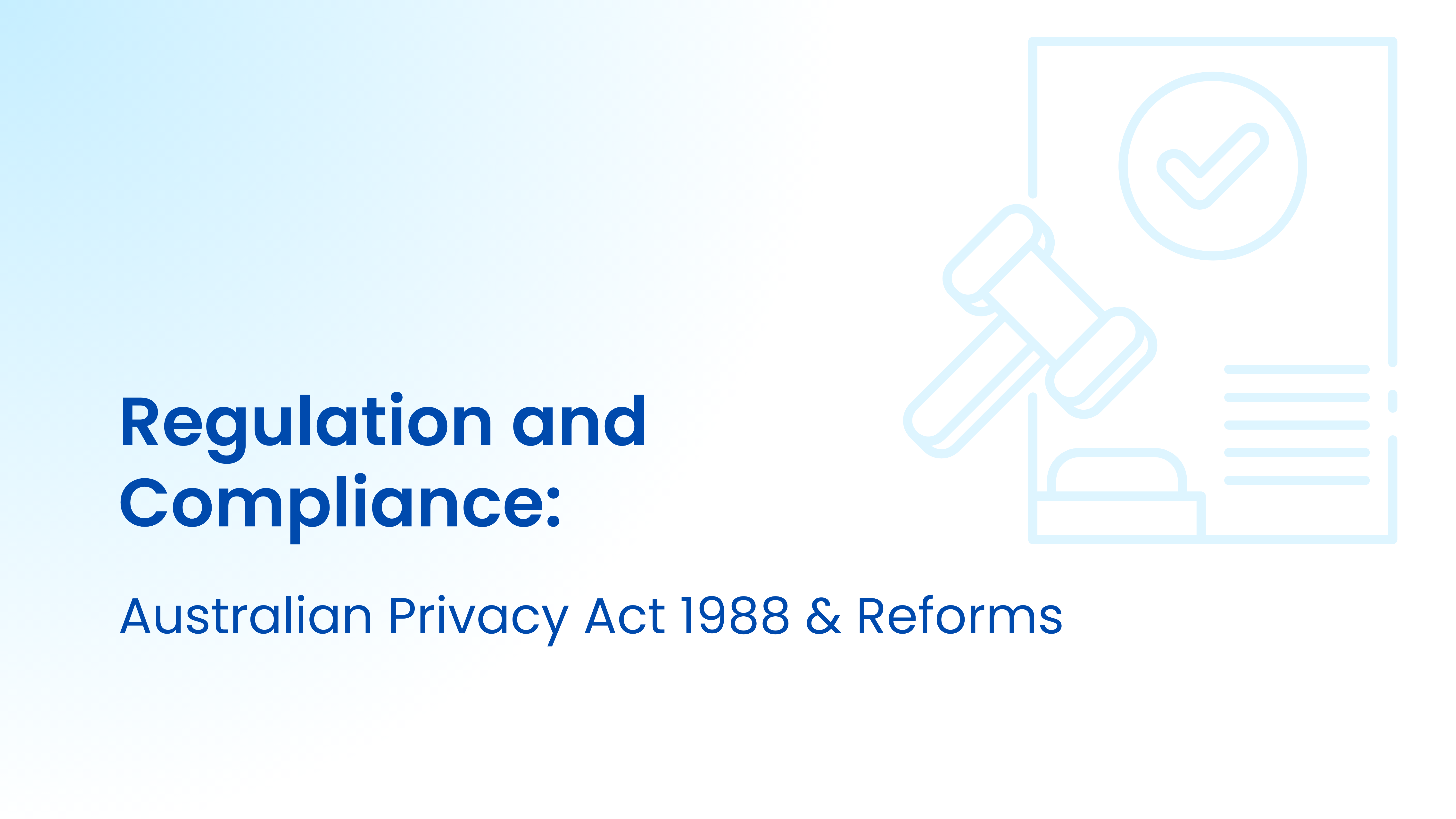AI agents have moved from R&D labs to business enablers in a blink, with nearly 9 out of 10 enterprises expecting deployment by 2025.
Yet many will never reach production yet half of pilot projects will stall because security and compliance concerns remain unresolved.
This leaves leaders with a dilemma: surge ahead and risk data breaches, or hold back and watch competitors gain the productivity and speed advantages of autonomous agents.
Zero Trust Architecture offers a way out. Already embraced by 63 % of organizations and considered best practice by security teams, it replaces “trust but defend” with continuous, identity‑centric verification.
Zero Trust is fast becoming the enterprise standard for modern security, but moving from aspiration to execution remains deeply challenging.
In this blog, we unpack how Zero Trust principles apply to AI agents so enterprises avoid the two biggest risks: obsolescence from delayed AI adoption and security incidents that are a result of insecure AI deployments. We showcase how enterprises can deploy Zero Trust at scale without losing the speed, flexibility, or business value that AI promises.
Traditional IAMs: Why the Old Security Playbook Fails
Traditional IAM, built for static, predictable environments, leaves a critical gap when facing AI native applications that are dynamic, autonomous, and context driven. As AI agents operate at machine speed, adapt their behavior in real time, and access sensitive data based on shifting contexts, legacy models fail to capture intent or enforce granular controls. The result is an expanding attack surface and increased risk, one that static roles and broad permissions simply cannot contain.
Traditional security assumes that anything within the network is safe, but this assumption no longer holds for AI agents, APIs, and cloud based services. Because AI agents operate within the network, old security tools cannot stop every risk, such as a bad prompt causing a failure. Zero Trust Architecture bridges this gap.
While traditional IAM models might suffice for legacy systems, their shortcomings become glaringly apparent as organizations adopt AI at scale. When access controls fail to keep pace, the resulting breaches, compliance violations, and operational disruptions have direct, measurable impacts on business performance and reputation.
Enterprises cannot securely launch or scale AI native applications with traditional IAM, leaving sensitive data exposed, compliance unprovable, and market opportunities out of reach. Weak IAM blocks revenue growth, stalls innovation, and hands competitors the edge in speed, trust, and regulatory readiness. Not having a robust AI security strategy isn’t just a risk; it's a direct barrier to the competitive, compliant, and profitable future that AI Agents bring.
Zero Trust Architecture for AI Agents
For AI driven enterprises, ZTA is more than a framework; it’s the foundation for secure autonomy. It redefines how trust is established and enforced in a landscape where agents act faster than humans can monitor.
Zero Trust Architecture (ZTA) replaces implicit trust with continuous verification. The principle is clear: never trust, always verify. Every user, device, and service is untrusted by default. ZTA’s principles are grounded in NIST SP 800-207, ensuring that access is granted only per session, and only after real time evaluation of identity, device posture, behavior, and context.
For AI agents, Zero Trust means that every action, whether a prompt, API call, or data retrieval, must be authenticated, authorized, and encrypted in real time. Access is dynamically assigned using least privilege and is informed by contextual signals such as agent identity, intent, data sensitivity, and behavioral patterns. This model shifts enterprise security away from static credentials and roles, requiring continuous verification of every agent’s behavior and purpose. The result is tightly scoped, auditable access that aligns with business policies and compliance mandates.
Zero Trust transforms the scale and autonomy of AI agents from a liability into a foundation for secure, compliant innovation. Autonomy is not unbounded. Every agent interaction is verified at every step, preventing misuse of privileges and ensuring explainable, policy driven AI operations. In this paradigm, identity, not the network perimeter, becomes the critical control point. This approach is perfectly suited to the dynamic, distributed world of AI agents.
Traditional perimeter security trusts internal traffic by default, relying on firewalls, VPNs, and segmentation to keep threats out. However, once inside, attackers or compromised agents can move laterally, escalating privileges and threatening core assets. Zero Trust neutralizes this risk by enforcing microsegmentation, fine grained authorization, and continuous validation, even for traffic within data centers or between cloud services.
Why Agents Demand Zero Trust
Beneath the innovation that empowers AI agent systems to operate with unprecedented autonomy lies a widening identity and governance gap that traditional IAM and perimeter controls cannot close. AI agents introduce new identity, access, and governance risks that break traditional security assumptions.
Invisible Identities and Overbroad Permissions
Most AI agents today operate without distinct, managed identities. They often run as scripts, cloud functions, or local processes, remain invisible to enterprise IAM systems, and therefore are unaccountable to governance controls. Instead of identity based access, they rely on shared API keys or inherited user credentials, creating over permissioned agents that can access far more than they should.
For instance, an LLM powered assistant might carry organization wide API tokens or admin credentials embedded in code, or static secrets that persist in memory, thereby violating every tenet of Zero Trust.
These long lived credentials effectively enable agents to move laterally across systems, perform privileged operations, and leak sensitive data without detection. As Okta notes, “AI agents often inherit permissions from users or systems,” turning a benign automation script into a potential insider threat if compromised.
Dynamic, Unpredictable Behavior
AI agents don’t follow static workflows. They spawn sub agents, invoke new APIs, and adjust behavior on the fly in response to prompts or evolving objectives. Traditional RBAC models, which are designed for predefined roles and predictable permissions, simply cannot keep pace with this dynamism.
But there’s an issue: agents often need to request new permissions at runtime or delegate tasks to other agents, but legacy IAM assumes static roles and manual provisioning. The result is blanket privileges that remain active long after a task is complete, amplifying both the attack surface and the blast radius.
Compounded Attack Surface and Real World Risks
When an over permissioned agent is compromised, it behaves like a privileged insider operating at machine speed. A single hijacked workflow can escalate privileges, exfiltrate data, or propagate malicious logic across systems within seconds. Cisco warns that emerging threats like prompt injection, secret collusion, and agent impersonation enable agents to rewrite directives or impersonate peers to execute unauthorized actions.
The data bear out the risk. 73% of enterprises report experiencing at least one AI related security issue, and by 2028, analysts forecast that a quarter of enterprise breaches will trace back to AI agent misuse. The financial stakes are equally high: organizations leveraging AI driven security controls see breach costs reduced by an average of $2.2 million, underscoring the tangible ROI of proactive controls.
Governance Gaps and Shadow Agents
The governance challenge compounds the technical one. In traditional architectures, central control points such as API gateways or DLP systems enforce policies and provide visibility. In multi agent ecosystems, those choke points vanish. Agents communicate directly, sometimes in memory or over ephemeral channels, beyond the reach of network based monitoring.
This creates a “shadow agent” problem: autonomous bots interacting, delegating, and exchanging data outside IT’s view. No single policy engine governs who can call what, or which agent can spawn another. If Agent A passes sensitive data to Agent B over an unmonitored channel and Agent B then calls an external API, traditional DLP lacks context to flag the violation. Without runtime instrumentation, there’s no way to enforce or even observe these interactions end to end.
Governance questions now take on new urgency:
- Who approves agent to agent delegation?
- Can an agent spawn another autonomously, and if so, who assigns its identity and scope?
- How is accountability maintained across multi agent chains?
Without a unified Zero Trust control plane for agents, these questions remain unanswered. Each agent becomes its own identity silo, and policy enforcement fragments across silos and codebases.
The Business Mandate: Zero Trust as a Precondition for AI Scale
For regulated sectors like BFSI and healthcare, where data integrity and privacy are non-negotiable, this fragmentation is untenable. 78% of banks are piloting AI, but only 8% have scaled, while in healthcare, half of the pilots (56%) stall due to security and privacy concerns.
The takeaway is clear: AI cannot scale without Zero Trust.
Zero Trust for AI Agents introduces ephemeral credentials, continuous verification, and contextual authorization, ensuring agents act only within the boundaries of their intent, with every decision traced and auditable. It redefines how trust is granted in systems where human oversight cannot keep up, turning automation from a liability into a strategic advantage.
For CISOs, the path forward is not to slow AI adoption, but to rebuild trust from the ground up, rooted in continuous verification, granular identity, and dynamic policy enforcement. Zero Trust is how enterprises transform AI from a governance nightmare into a competitive differentiator.
What Zero Trust Architecture Protects Against
A well implemented Zero Trust Architecture (ZTA) for AI agents does more than add another layer of security; it defines the boundaries of safe autonomy. It transforms how organizations contain risk, enforce compliance, and sustain business resilience in an era where AI operates faster than human oversight can respond.
1. Blocking Lateral Movement and Limiting Blast Radius
At its core, Zero Trust prevents compromise from turning into contagion. By enforcing least privilege access and microsegmentation, every AI agent is confined to a tightly scoped operational domain. Once an agent’s identity and intent are verified, only its explicitly approved actions are permitted, nothing more.
This principle is central to Gartner’s view of Zero Trust: microsegmentation is the most effective way to stop lateral movement by isolating workloads and applications. Without these controls, a compromised agent can pivot freely across cloud APIs and data stores.
Zero Trust policies neutralize this risk by throttling or outright denying cross system access, reducing the blast radius of any single breach. Even if one agent is compromised, the attacker’s reach ends at the microsegment boundary, protecting the rest of the enterprise fabric.
2. Preventing Data Exfiltration
Data is a gold mine that AI agents frequently access, and Zero Trust ensures that every access is intentional, justified, and auditable. By requiring explicit justifications and session based approvals for sensitive data operations, ZTA makes it exponentially harder for agents or attackers to siphon data undetected.
Consider an agent in a retrieval augmented generation (RAG) workflow. Without ZTA, it might autonomously retrieve records far beyond its scope, a risk where agents may access data beyond user permissions if unchecked. A Zero Trust control plane intercepts such calls, verifying purpose and policy alignment in real time using attribute based access control (ABAC). Unauthorized or out of scope requests are simply blocked.
By logging every operation and decision, Zero Trust builds an immutable forensic trail. Whether for insider threats or AI malfunctions, security teams gain full visibility into which data was accessed, by which agent, and for what reason, ensuring breaches don’t go undetected for months.
3. Ensuring Regulatory Compliance and Auditability
Compliance frameworks such as GDPR, HIPAA, SOC 2, and ISO 27001 require demonstrable control and traceability over every system that handles sensitive data. AI agents complicate this by acting autonomously, often without discrete credentials or audit trails.
Zero Trust solves this by treating each agent as a digital subject with its own verifiable identity, rotating credentials, and logged activity. Since regulatory obligations can't be met without clear, auditable identities and actions, every AI agent should have a cryptographically verifiable identity tied to policy driven permissions.
This aligns directly with the NIST AI Risk Management Framework, which calls for systems to be “secure, resilient, and accountable.” Under a Zero Trust model, organizations can prove that:
- Only authorized agents accessed sensitive data.
- Access occurred for legitimate, policy aligned purposes.
- Every interaction was logged, reviewed, and auditable.
For compliance officers and CISOs, ZTA turns AI governance from a liability into a verifiable, defensible control system.
4. Stopping Operational Disruption
AI agents don’t just pose data risks; they can also threaten operational stability. A single misconfigured or runaway agent can trigger cascading failures, runaway compute costs, or even denial of service conditions.
Multi agent workflows can unintentionally amplify errors or hallucinations, creating “AI driven feedback loops” that overwhelm systems. Zero Trust mitigates this by enforcing session time to live (TTL), resource quotas, and continuous behavioral monitoring.
If an agent starts deviating from its normal behavior by consuming excessive resources, spawning unauthorized sub agents, or accessing anomalous APIs, ZTA engines can revoke its tokens in real time. In effect, Zero Trust becomes a safety circuit breaker for automation, halting potential incidents before they cascade into outages or financial loss.
5. Sustaining Business Continuity
When incidents do occur, Zero Trust dramatically reduces detection time, investigation complexity, and recovery costs. By containing threats within microsegments and maintaining detailed telemetry, ZTA accelerates forensic response and root cause analysis.
For CISOs, this means the difference between a localized event and a full scale crisis. With Zero Trust, breaches are isolated, auditable, and recoverable, preserving customer trust, uptime, and regulatory standing.
In essence, Zero Trust is not a defensive upgrade but an operational imperative for AI driven enterprises. It brings control, compliance, and continuity back to environments defined by autonomy and speed.
Applying Zero Trust Architecture to AI Agents
Zero Trust Architecture (ZTA) moves from concept to control when applied to AI agents. As enterprises operationalize autonomous systems, ZTA provides the blueprint for verifiable trust, ensuring every agent action is authenticated, authorized, and auditable.
NIST SP 800-207 advises eliminating implicit trust and continuously evaluating every request based on identity, intent, and context. For AI, that means no agent, even one operating inside the firewall, is trusted by default.
Applying Zero Trust to AI agents involves re-engineering its principles for autonomous, machine to machine workflows:
1. Unique Identity for Every Agent
Security starts with identity. Each AI agent, or even each instance, must have a unique, attestable identity, similar to a digital VIN. Microsoft’s Entra Agent ID exemplifies this by issuing distinct credentials for every process, enabling precise attribution and control. These identities can be short lived, certificate based, and lifecycle managed (creation, rotation, revocation) through integration between IAM systems and AI orchestration platforms. Without a unique identity, accountability, policy enforcement, and auditing become impossible.
2. Strong Authentication and Dynamic Authorization
Every agent request should be treated like a human user’s, authenticated and authorized in real time. Agents must use individual least-privilege tokens, never shared credentials, to access APIs or data. Authorization must be dynamic and contextual, factoring in who the agent represents, what it’s attempting, and risk signals such as device posture or behavioral anomalies. Implementing policy decision points (PDPs) that evaluate identity, action, and context ensures access remains per session and revocable on demand.
3. Microsegmentation and Micro Policies
Zero Trust demands granular containment. Segment data, tools, and workflows so each agent can reach only what it needs, when it needs it. Define micro policies for contextual control; for example, a travel booking agent can interact only with travel APIs and calendars, not with finance or HR systems. If compromised, the agent is confined within its micro perimeter, limiting breach impact and simplifying response.
4. Least Privilege and Scope Control
Agents should operate with just in time, context bound credentials. They should replace standing tokens with ephemeral access grants that expire immediately after use. Over permissioned tokens are one of the most common and dangerous oversights in AI system design. Rights inheritance should also follow the “least privilege by delegation” model; an agent inherits only the permissions of the user or service that invoked it, nothing more.
5. Continuous Monitoring and Auditability
Visibility is non-negotiable. Log every prompt, API call, and data access with tamper evident audit trails linking back to both the initiating user and the agent identity. This dual identity model (“who authorized” and “who executed”) enables forensic clarity. Continuous monitoring systems should baseline agent behavior and flag deviations.
For example, abnormal data volumes or unauthorized system access. Extending SIEM and UEBA capabilities to cover AI agent behavior closes the visibility gap and supports compliance under NIST’s dynamic access tenets.
6. Fallback Controls and Kill Switches
AI autonomy must never outpace operator control. ZTA mandates real time containment mechanisms by revoking credentials, pausing sessions, or terminating rogue processes at the first sign of anomaly. Think of this as an emergency brake for intelligent systems: critical for both cyber defense and operational stability.
7. Human in the Loop and Governance
Automation doesn’t replace accountability. Sensitive or high impact agent actions (such as financial approvals, data exports) should trigger human review or dual authorization. Many regulated sectors now establish AI governance committees, already present in over 60 % of healthcare organizations to oversee policy adherence, audit findings, and ethical boundaries.
Zero Trust for AI agents is not a theory, it’s the operational discipline of secure autonomy. By binding every agent to an identity, validating every action in context, and maintaining continuous visibility, enterprises create an environment where AI can move fast without breaking trust.
Operational Hurdles in ZTA Implementation for AI Agents
Implementing Zero Trust for AI agents is far from plug and play. While the “never trust, always verify” principle is sound, enforcing it in a world of dynamic, autonomous agents exposes deep operational and architectural gaps. Understanding these challenges is critical for CISOs and security leaders as they chart their enterprise AI strategy.
1. Ephemeral Identities
AI agents don’t live long enough for traditional IAM workflows. They spin up, perform tasks, and disappear in seconds, often before credentials can be provisioned or revoked.
This transient lifecycle makes just in time identity issuance, continuous authentication, and real time logging non-negotiable yet non-trivial. Without adaptive credentialing, organizations risk blind spots where untracked agents execute high impact actions.
2. Delegation Chains and Multi Agent Flows
Agent ecosystems rarely operate in isolation. One agent may delegate a task to another, often across different trust domains or even providers. Tracking these chains (“who authorized whom”) remains unsolved, as no standard protocol exists to convey delegation context. The absence of a consistent chain of custody undermines accountability and auditability, complicating incident response and compliance.
3. Bypassing Network Controls
Traditional Zero Trust relies on network visibility, but agents frequently communicate through APIs, SDKs, or in process calls that never hit a firewall or proxy. These invisible pathways bypass traditional DLP, EDR, and segmentation layers, creating a blind spot where policy enforcement must shift up the stack, to the application and identity layers.
4. Shadow Agents and Misconfigurations
Developers often experiment with AI automation, creating “shadow agents” that operate outside sanctioned IAM controls. These agents may carry hardcoded keys, overprivileged access, or no traceability. Without centralized registration or attestation, such agents erode Zero Trust assumptions and expand the attack surface across clouds and SaaS ecosystems.
5. Unified Observability and Policy Enforcement
Achieving a single, coherent view of agent activity is difficult when agents operate across multiple platforms, each with distinct logs, telemetry, and identity models. Fragmented visibility means policies are inconsistently applied, and behaviors that look benign in isolation may signal coordinated risk when viewed holistically. Consolidation is essential but remains elusive with current tooling.
6. Nascent Standards and Inter-Agent Governance
The technical standards for AI agent IAM are still emerging. The IETF has only begun exploring lightweight trust models for ephemeral agents and distributed key management. In practice, organizations must build adhoc “agent controllers” that assign identities, issue policies, and broker inter-agent communication, similar to how device management systems onboard hardware.
7. Mindset Shift: From Implicit Trust to Continuous Verification
The heart of the challenge is cultural as much as technical. As one CISO put it, “Agentic AI doesn’t get a free pass because it’s smart, it must earn trust continuously.” Treating AI agents like human employees in a secure environment, verifying identity, enforcing least privilege, and monitoring every interaction is the mindset Zero Trust demands.
How Levo accelerates Zero Trust Architecture Implementation
Enterprises are racing to adopt Zero Trust Architecture as the backbone for AI-driven growth, with 63% of organizations worldwide having fully or partially implemented it as of 2024, according to Gartner.
Those that succeed are realizing measurable gains: higher margins, faster revenue, and a clear competitive edge. Yet, achieving these gains is not straightforward, as 62% anticipate cost increases and 41% expect higher staffing needs to operationalize it.
The real challenge is execution. Levo quietly bridges this gap, translating Zero Trust vision into rapid, secure AI deployment at scale. As market leaders surge ahead, the choice becomes clear: solve the Zero Trust challenge, or risk getting left behind.
Levo makes this possible by embedding Zero Trust principles directly into the fabric of AI operations, enabling enterprises to adopt AI agents at scale, securely, compliantly, and confidently. The result is a future where innovation moves faster, not at the expense of control, but because of it.
Levo unifies discovery, identity, monitoring, enforcement, and compliance into one continuous lifecycle. It replaces reactive detection with proactive AI monitoring and governance, turning AI agents from opaque, autonomous entities into verifiable, policy bound digital teammates.
1. Discovery and Identity Attribution
Zero Trust begins with knowing what you’re securing. Levo’s Phase 1 runtime sensors, powered by eBPF, continuously discover every AI asset, i.e., agents, LLMs, MCP servers, and plugins, across your environment. Each entity is automatically mapped to its owner, purpose, and session, creating a living identity inventory. This attribution layer establishes the “never trust by default” baseline essential for any Zero Trust model.
2. Continuous Monitoring and Policy Enforcement
Once agents are visible, Levo enforces control. Phase 2 modules continuously inspect agent-to-agent and agent-to-resource interactions, attributing each session to a verified human or service identity. With policy as code, organizations can define granular, context aware rules such as “Finance agents may only access CRM data during business hours.”
Levo enforces these policies in real time, transforming static governance into dynamic, continuous verification.
3. Dynamic Detection and Microsegmentation
Levo’s Phase 3 detection layer validates agent behavior against both policy and intent. It checks identity chains, session drift, data classification, and geo/vendor boundaries, ensuring each agent operates within its authorized context. Fine grained microsegmentation separates agents by trust zone, while runtime guardrails detect and block risky behaviors such as prompt injection, data leakage, or unauthorized delegation.
4. Runtime Blocking and Kill Switch
When policy violations occur, speed matters. Levo’s Phase 4 agent firewall acts instantly, blocking rogue agent sessions, isolating compromised workloads, or redacting sensitive data like PII/PHI in transit. Adaptive, intent aware policies can restrict high risk actions by data type, region, or cost threshold. In effect, it gives security teams a real time “kill switch” for agentic misbehavior, without halting legitimate operations.
5. Security Testing and Compliance Assurance
Before deployment, Levo’s Phase 5 testing modules simulate adversarial scenarios, agent tool abuse, prompt fuzzing, collusion, and plugin vulnerabilities, to validate compliance with Zero Trust principles. This proactive testing ensures agents are secure before they reach production, closing the loop between development and runtime security.
6. Alignment with Regulated Environments
Designed for hybrid and on-prem contexts, preferred by 80% of regulated enterprises, Levo generates immutable audit trails aligned with BFSI, healthcare, and government standards. This provides provable assurance that every agent action is traceable, compliant, and in compliance with policy.
Contact Us to see how Levo enables secure and compliant AI adoption at scale with confidence.








